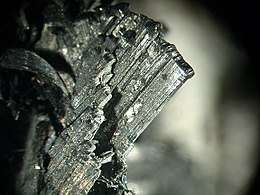Franckeite
Franckeite, chemical formula Pb5Sn3Sb2S14, belongs to a family of complex sulfide minerals. Franckeite is a sulfosalt. It is closely related to cylindrite.
| Franckeite | |
|---|---|
 Franckeite var. Potosíite, San José Mine, Cercado Province Bolivia. Field of view about 10mm. | |
| General | |
| Category | Sulfosalt mineral |
| Formula (repeating unit) | (Pb,Sn2+)6Fe2+Sn2Sb2S14 |
| Strunz classification | 2.HF.25b |
| Dana classification | 03.01.04.02 |
| Crystal system | Triclinic |
| Crystal class | Pinacoidal (1) (same H-M symbol) |
| Space group | P1 |
| Identification | |
| Color | Grayish black |
| Crystal habit | Typically in spherical, rosette aggregates of thin plates; commonly massive, radiated, or foliated |
| Twinning | Complex |
| Cleavage | {010}, perfect |
| Tenacity | Flexible, inelastic; slightly malleable |
| Mohs scale hardness | 2.5 - 3 |
| Luster | Metallic |
| Streak | Grayish black |
| Diaphaneity | Opaque |
| Specific gravity | 5.88 – 5.92 |
| Pleochroism | Weak |
| References | [1][2][3] |
It was first described in 1893 for an occurrence in Chocaya, Potosí Department, Bolivia. It is named after the mining engineers, Carl and Ernest Francke.[2] It can be found in Bolivia at Poopó in Oruro and at Las Aminas, southeast of Chocaya, in Potosi. Franckeite has an average density of 5.7 and can be both grayish black, blackish gray in color.
It occurs in hydrothermal silver-tin deposits in Bolivia and in contact metamorphosed limestone deposit in the Kalkar quarry in California. It occurs with cylindrite, teallite, plagionite, zinkenite, cassiterite, wurtzite, pyrrhotite, marcasite, arsenopyrite, galena, pyrite, sphalerite, siderite and stannite.[1]
References
- http://rruff.geo.arizona.edu/doclib/hom/franckeite.pdf Handbook of Mineralogy
- http://www.mindat.org/min-1592.html Mindat with location data
- http://webmineral.com/data/Franckeite.shtml Webmineral data
| Wikimedia Commons has media related to Franckeite. |